I finally got around to getting some backup iron sights (BUIS) for my 16″ AR-15 build by acquiring a set of Knight’s Armament Company (KAC) Micro sights.
The AR-15 platform has evolved quite a bit since the original design. One significant evolution from the original design by inventor Eugene Stoner is the omission of iron sights.
The core design of the AR-15 rifle had the rear sight integrated into the upper receiver (within the carry handle) and a front sight was attached to the gas block on the barrel. By and large, this design was standard for the US military in the M-16 variants up until the M-16A4 (early 2000’s) which had a removable carry handle.
Around the early 2000’s, so-called flat-top AR-15 rifles (with no carry handle / rear sight) became predominate in the market. Now, the majority of the AR-15 rifle sold are flat-top. This is most likely due to the shift in using optical sighting systems on the AR-15, specifically red dot sights (e.g. Aimpoint), which later included other designs such as the EOTech and the Trijicon ACOG.
The fact that most of the AR-15 rifles sold are flat-top variants, many people end up using flip-up iron sights instead of an optic (either due to financial reasons or by choice) as their only sighting system. The problem is that most of the flip-up sights are considered BUIS and BUIS in general don’t have rear elevation adjustments, and the only elevation adjustments can be made using the front sight post. Granted, you can get an elevation zero on a set known distance (e.g. 200 yards). But after that, you’re pretty much stuck with that elevation zero unless you want to make a front sight post adjustment. This is fine at the range, but in the field this isn’t very expedient at all.
Growing up on the AR-15 with A2 sights, and competing in High Power Rifle matches using the Service Rifle, I am very much used to having a rear sight with elevation adjustments. If I have a 200 yard zero, but need to make a 600 yard shot, I can quickly just run the elevation knob to my known 600 yard zero in a few seconds and take the shot.
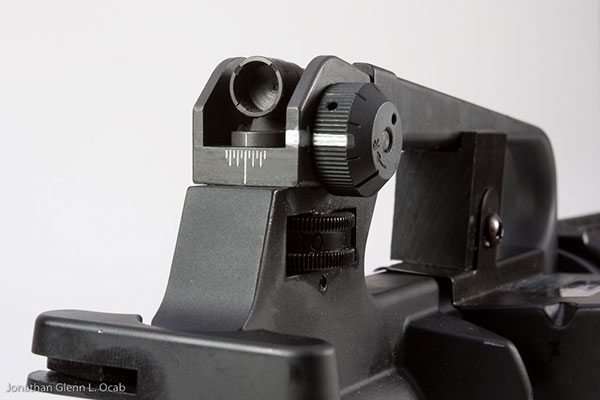 After reading this background information, you now know my mindset when I was shopping around for a set of ‘BUIS’ to compliment the primary optic on my rifle (Aimpoint Micro T-1).
After reading this background information, you now know my mindset when I was shopping around for a set of ‘BUIS’ to compliment the primary optic on my rifle (Aimpoint Micro T-1).
The KAC Micro rear sight is the only rear flip-up sight that I found with both windage and elevation adjustments. There are a few rear sight variants by KAC, but I went specifically with the KAC Micro 600M Rear Flip Sight.
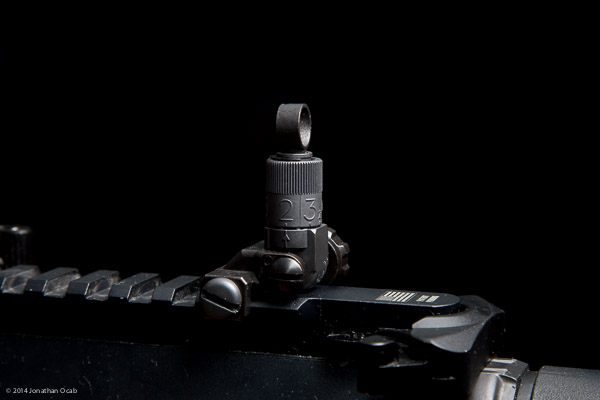 As far as the front sight, I went with KAC Micro Front Flip Sight.
As far as the front sight, I went with KAC Micro Front Flip Sight.
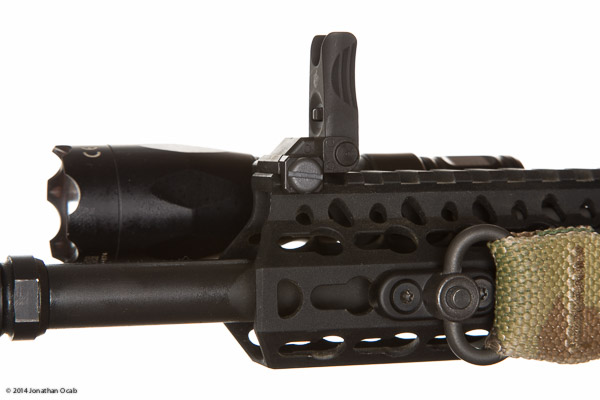 The ‘Micro’ nomenclature simply means the steel KAC sights were designed to be very low profile so they stay out of the way and can clear a scope body (in the case of the rear) when in the down position.
The ‘Micro’ nomenclature simply means the steel KAC sights were designed to be very low profile so they stay out of the way and can clear a scope body (in the case of the rear) when in the down position.
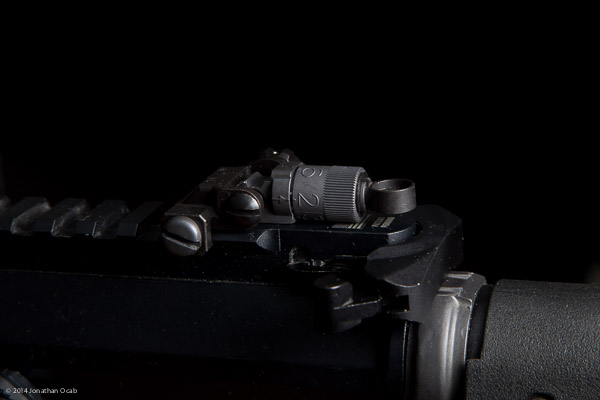 The specific difference between the Micro rear and the regular (non-Micro) rear KAC sights is that the windage knob is smaller on the Micro. I had considered getting the regular version since the windage knob is larger and similar in size to the windage knob of a traditional A2 rear sight. Having a ‘full size’ windage knob sounded appealing since I’m used to them and it might be easier to manipulate with gloves on. But I decided to risk the Micro rear to go as low profile as I can.
The specific difference between the Micro rear and the regular (non-Micro) rear KAC sights is that the windage knob is smaller on the Micro. I had considered getting the regular version since the windage knob is larger and similar in size to the windage knob of a traditional A2 rear sight. Having a ‘full size’ windage knob sounded appealing since I’m used to them and it might be easier to manipulate with gloves on. But I decided to risk the Micro rear to go as low profile as I can.
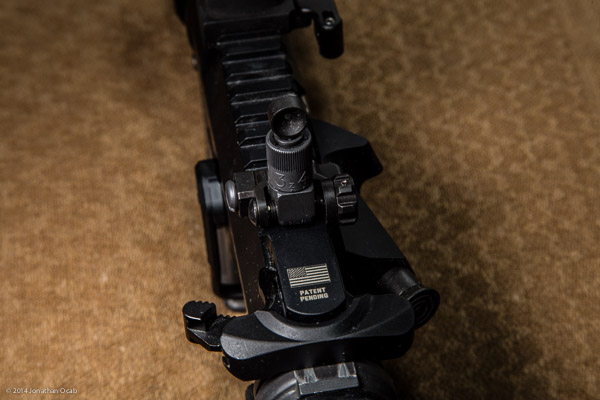 That being said, the windage knob is easily manipulated while wearing gloves.
That being said, the windage knob is easily manipulated while wearing gloves.
The flip-up / flip-down action of the sights seems very solid and they lock firmly into place. What I also like about the operation of the KAC Micro 600M rear is that it feels like I’m using an A2 rear sight in terms adjustments; windage knob on the right, elevation wheel on the turret.
Size and form factor aside, the key feature that sold me on the KAC Micro 600M Rear Flip Sight is the 200 to 600 meter elevation adjustment range. The elevation is adjusted by simply turning the rear sight turret which has the hash marks for what is expected to be the 200, 300, 400, 500, and 600 meter zeros. Naturally, the accuracy of the hash marks has a lot do with initial zero, ammo used, sight radius, so the hashes should be treated as being exact.
I set a rough 200 meter zero; ‘rough’ meaning that I don’t have a laser range finder and set my target at my home range where I believe 200 meters should be (within 10 meters or so). I simply set the turret to the ‘2’ hash mark, adjusted the front sight post until I was hitting point-of-aim (POA). When I get a chance, I’m going to verify the zero at known distance, specifically 200, 300, 500, and 600 yards. Note yards not meters. The Santa Margarita Gun Club hosts matches at Marine Corps Base Camp Pendleton, and the range we use has 200, 300, 500, and 600 yard firing lines. I don’t expect the hash marks to coincide exactly with the yardage firing lines at the MCBCP range, but I will want to know what I need dialed in on the rear sight for 300, 500, and 600 yards with a 200 meter (or even a 200 yard) confirmed zero.
There are only two negative issues I found.
One issue is that the cross bolt that is used to tighten the sights onto the Picatinny rail is a slotted / flat head. I would have preferred the cross bolt use a hex head or Torx head for better torque and less likelihood of stripping the head. Also, if one wanted to use a torque wrench, I most people have sockets with hex and Torx bits.
The other issue is the price. The KAC sights cost more than all the other BUIS on the market running around $150 for each the front and rear. That means just over $300 for the pair, when you can often get competing BUIS sets for less than the cost of one KAC front or rear. For example, a popular option on the market is the MagPul Industries MBUS Generation II (polymer) sights which can be had for as little for $75 for the set (both front *and* rear) which is a quarter the cost of the KAC set. Even the MagPul MBUS Pro (steel) sights are under $150 for front and rear set.
Most people see the KAC sights and balk because of the price. I did, too. But unfortunately, I have the deep seeded desire for a quality rear sight with elevation adjustments and was willing to spend on the KAC Micro flip-up sights.
Anyway, if you are looking for a quality steel flip-up rear sight with full windage and elevation adjustments, look at the KAC Micro sights. Should you spend the money or seek a cheaper alternative? If you are actually putting flip-up iron sights on your rifle for your primary (and only) sighting option, then I would highly recommend the KAC flip-up sights. If you are looking solely for a simple “backup” for your primary optic, then you can probably settle for a cheaper alternative.
For me, I do not regret the purchase because I have full confidence in the usability and quality of the KAC Micro flip-up sights.

Hassan
Hi Jonathan,
Great article. I have the same set if iron sights and zero 25 meters on the “Z” hash mark between the “3” and “4” hash marks. Though I have not tested them out to more than 100 yards, the instructions state the “Z” hash mark should correspond to a 200 meter zero when flipped back to the “2” hash mark.
I would be curious how close your POI is with relation to the hash marks with known distances. Additionally, I am curious how different grain bullets will correspond to the hash marks, I recall you mentioning you typically reload your 5.56/.223 brass with 77gr BTHP bullets.
ocabj
The gun that I put the KAC Micros on is basically a generic ‘battle’ gun that I only run (X)M193 in. I never bothered to shoot 77gr handloads in this. I have yet to shoot it at 200/300/500/600, either.
David Walters
I run and Vortex Sparc II RDS on the front pic rail of the upper receiver, the standard A2 front sight and a KAC 600m micro sight for the rear. As the author says, I grew up with iron sights and, well, simply won’t be without elevation and windage adjustable sights along with optics.
But one thing about the KAC documentation that accompanied the rear sight intrigued me. That was that the dope card suggested that the dope corresponding to the tower engravings was, essentially, an average over several barrel lengths. OK, fine. Makes sense, I guess.
But, surprisingly, when I used my two 16″ barreled carbines and fired various ammunition (six different loads from two different rifles from the very flat-shooting Federal AE LC 55 gr XM193 to the less flat-shooting Black Hills 77 gr ballistic tip SMK262 and everything in between) I found that if I also averaged the dope between these rounds the major hash marks (200 – 600m) were accurate on a man-sized torso target even when range tested.
I’ve not done this, but I suspect that if one were to zeroan AR at 200m or 300m using XM193 then almost any other reasonably high MV 5.56 ammunition could be used as well on torso sized targets without further testing simply using the hash / elevation marks on the existing sight turret.
So, IMHO the KAC 200 – 600m micro sight seems to be an exceptionally fine piece of gear as the ballistic averaging proved to be highly beneficial in that most well-made ammunition will conform to the elevation tower markings (hash marks) with introducing undue inaccuracy down range.
LF
Hassan
Great info David, thanks for posting this. I still haven’t gotten around to testing this myself yet, but it’s good to know that someone has. How far out did you go with the irons (200 – 600m)?
ocabj
Supposedly, the 600M rear is 1/2 MOA per click on a 20″ and 3/4 MOA per click on a 16″. It has 5 clicks from the 2 to 3 mark, and 22 clicks from the 3 to 6 mark. So you figure, 2.5 MOA / 3.75 MOA for 2 to 3 and 11 MOA / 16.5 MOA for 3 to 6 (20″ and 16″ respectively). There’s the old High Power rule of 2-3-11, where you need 2 MOA from 100 yard zero to get into the black at 200, 3 MOA from 200 yard zero to get into the black at 300, and 11 MOA to get into the black (or at least on paper) from 300 yard zero at 600. The KAC 600M rear seems to be fairly inline with this ideology.
David Walters
Ocabj,
As I have old eyes and less than perfectly steady positions nowadays, I use a Lead Sled PFT with my two 16″ barreled rifles strapped down fore, aft and to the rear to sight sight in my rifles, to compare accuracy and precision of commercial loads and to establish sight repeatability and to perform the box test to find what the MOA per click is in elevation and windage for each of my rifles at 100 yards. The box test showed that my rifle and my wife’s almost identical rifle were 0.625 and 0.653 MOA / click elevation, respectively. So, it’s a bit different from the documentation that accompanied the KAC sight for a 16″ barrel which, as you correctly recited, suggests a 0.75 MOA / click.
Still, my measured MOAs / click lead to a similar conclusion about the old dogmas as yours using the manufacturer’s MOA / click.
Hassan, I’ve only shot with the KAC out to 500m. I’m sorry if my account mistakenly implied I’d fired out to 600m.
LF
David Walters
Just a few more things on the KAC sight if you don’t mind.
I have two for my wife’s and my rifle. When zeroed the number of right and left windage clicks for both rifles are about 50 left and 25 right for a total of about 75 clicks. But, when I used Infinity Ballistics Softward (7) to worked up my elevation and windage cards (http://s1378.photobucket.com/user/longfisher/library/) I noticed that I needed more than 30 on each side to correct for windage for a 25 mph wind a ranges out to and beyond 500 m. So, I needed to center the tower within the sight to more equally split the available clicks.
I wrote to KAC about shimming but haven’t gotten an answer. So, being the impatient sort I decided to try a few things.
Trouble was that the fixed pic rail attachment point on the right side of the sight needed the shimming to move the tower towards the middle, rather than the non-fixed side near the screw head which would have been simpler.
I tried brass shims in several layers to get the adjustment but finally settled on using rubber. I found a rubber grommet which had a hole size the same as the KAC sight attachment screw, cut it in half across the diameter of the grommet and then again across the flat plane of the resulting half grommet. When wedged into place and the sight tightened I found that I could adjust the number of clicks on each side by adjusting the torque of the mounting screw.
With a little patience and using an absolute co-witnessed RDS to find zero, I ended up with exactly 38 clicks on the left and 37 on the right.
But being careful, I took it apart, applied blue locktite, inserted the other unused half of the half of the grommet and cranked away until I got it just right again with new rubber. When I went to the range to test the zero I was but on windage click off. So, it’s now 37 clicks left and 38 clicks right.
It’s been six weeks of shooting now at the range and the sight has held both its position on the rail, it’s zero and the number of clicks of right and left windage ever since.
So, if you too end up with an windage adjustable sight, perhaps including those other than the KAC, and, if it appears that you don’t have equal amounts of windage clicks right to left try shimming it on the pic rail. Worked for me.
LF